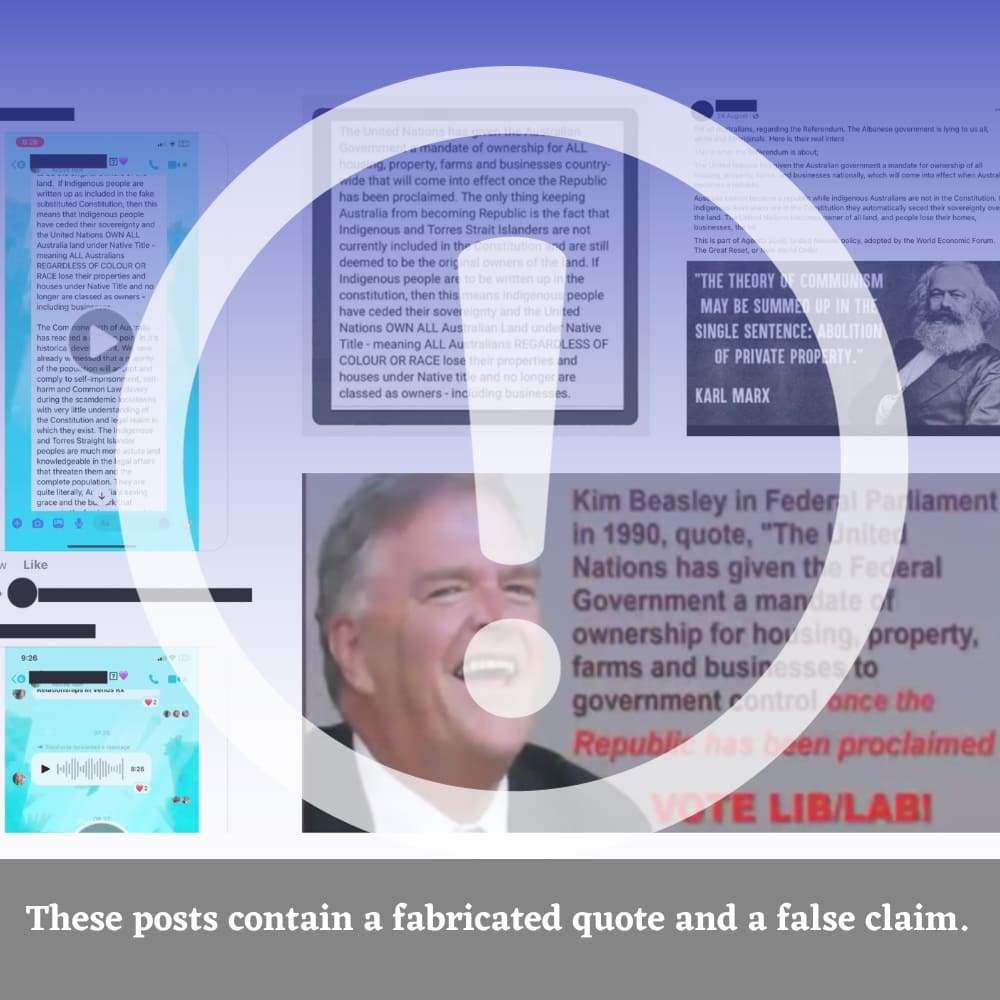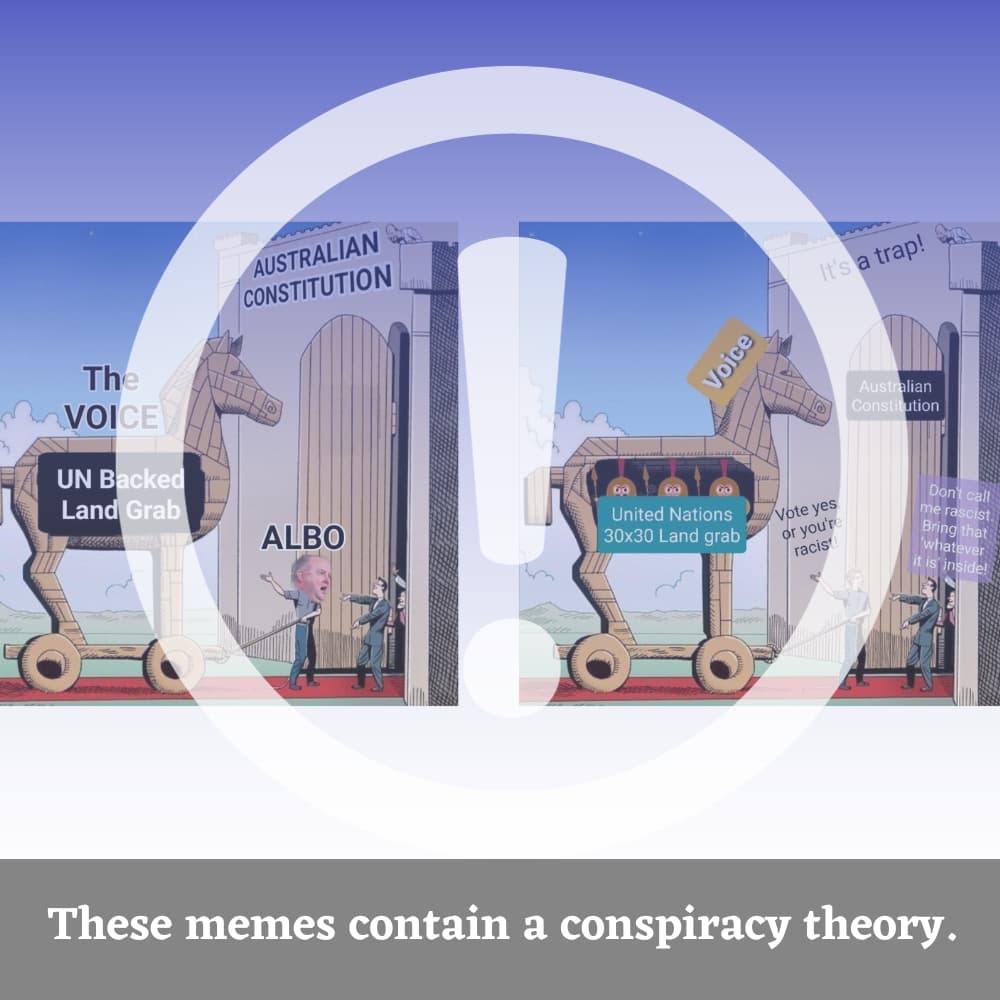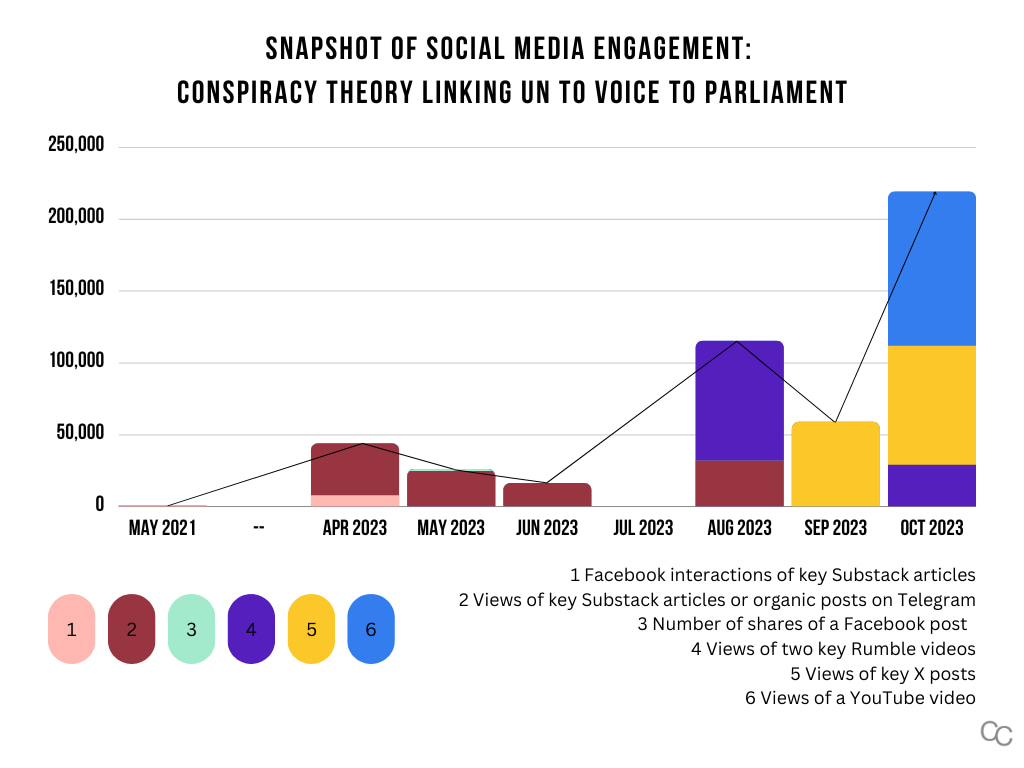
UN conspiracy theory evokes fear in Voice voters
This article chronicles when and how the Voice to Parliament referendum got caught in a conspiracy theory positing that the United Nations could take over Australia if a Yes vote was achieved.
By Esther Chan, Eiddwen Jeffery, Maryam Mahvash
Introduction
Some four years after the Uluru Statement from the Heart was delivered, an appeal that “The Voice must not proceed” emerged on the newsletter platform Substack in May 2021.
Little did we know in two years’ time, this type of appeal or warning would become fodder for a conspiracy theory that preyed on fears over elite land grabs.
The newsletter, penned by a former member of the Indigenous Voice Co-Design Senior Advisory Group, listed nine reasons against the Voice — the first of three sequential reforms proposed in the Uluru Statement for the constitutional recognition of Indigenous Australians.
All but one reason were related to Australian politics and legislation. The odd one out was detailed in the section “UN and The Green Elites”, in which two points were made. First, the preamble of the Native Title Act 1993 (Cth) refers to the United Nations’ Universal Declaration of Human Rights (UDHR); and second, the Uluru Statement acts in accordance with the United Nations Declaration on the Rights of Indigenous Peoples (UNDRIP). These were true.
Other than Substack, the list was published later in 2021 on the author’s website, and subsequently promoted on her X account.
While it has had limited views on all of those platforms, the point it made about the UN being referred to in the Uluru Statement has since ballooned into a fully-fledged conspiracy theory. In fact, the author was later credited as having “discovered a plot by the United Nations to use the decoy of the ‘Aboriginal’ and ‘Indigenous Rights’ to asset-strip Australia and to remove all private land ownership”.
Conspiracy theory linking Voice referendum to UN
Fast forward to 2023, the UN had been brought back into the Voice debate just months ahead of the referendum.
This time, the intergovernmental organisation was referenced in several unsubstantiated claims that speculated its involvement in the Voice referendum. These claims, which could be referred to collectively as the “UN conspiracy theory” about the Voice, primarily highlighted a purported UN power grab and/or land grab in Australia.
Native title
Proponents of the theory alleged that a “land grab” might be achieved via a UN determination of native title upon a successful referendum, since its UDHR is featured in the preamble of Native Title Act 1993 (Cth).
This claim is false. First, native title, which is the recognition of pre-existing Indigenous rights and interests to land according to traditional laws and customs, is not part of what the Voice proposed. The passing of the referendum would have had no impact on Aboriginal and Torres Strait Islander peoples’ native title rights.
Dr. Harry Hobbs, an associate professor in constitutional law and Indigenous treaty at the University of Technology Sydney, told RMIT Fact Lab in June that “private land cannot be transferred to native title”, which he said “is only available where traditional owners can prove a continuing connection to their traditional lands and waters… It is no longer available on lands that are owned privately.”
Dr. Kate Galloway, an associate professor at Griffith University’s Law School also told CrossCheck that “Native title is an expression of Australian law. It's not international law,” adding that the Act’s preamble is “a recognition that the context for making provision for Native Title was part of Australia's commitment to remove or to deal with racism, in the context of our laws. That's the purpose that they serve; they don't even have any substantive role. It's not like you can apply the provisions of those treaties in the act; they are just scene setting provisions in the beginning of the act.”
UNDRIP
Then there was the question about the UNDRIP, a legally non-binding resolution that defines and sets forth the rights of Indigenous people and which Australia formally endorsed in 2009. Online claims stated that through the Voice, UNDRIP would be implemented in Australia.
While UNDRIP is credited in the guiding principles for the Uluru Statement (see “2. Involves substantive, structural reform” in P95-96 of the addendum), this does not empower the UN or any foreign organisation to intervene in Australia’s domestic, legal matters. Article 2(7) of the United Nations Charter stipulates that the UN does not have any mandate or control over the actions of any member state — including Australia.
“There have been a number of statements and policy documents prepared by Indigenous Australians over the years that make reference to the UNDRIP,” Monash University’s law lecturer and Indigenous rights expert Dr. Katie O’Bryan told CrossCheck. “The United Nations does not have any power to supersede Australia’s sovereignty through national Indigenous policy that references UN treaties or declarations. Policy is not legally enforceable. If Australia has ratified a United Nations treaty, convention etc, it is only enforceable in Australia if the Australian Parliament has passed legislation to implement it”.
Agenda 21, Agenda 2030
In addition to these claims, the conspiracy theory also suggested that UN Agenda 21 and Agenda 2030 dictated the Uluru Statement’s proposed reforms of Voice, treaty, and truth-telling.
Both agendas are non-binding documents detailing global sustainable development goals that UN member states, including Australia, endorsed in 1992 and 2015.
While both agendas note the importance of recognising and protecting Indigenous peoples and may have inspired parts of the Uluru Statement, neither mention any of the details proposed in the Statement.
It is worth noting that both agendas have been embroiled in a myriad of conspiracy theories related to the Covid pandemic, smart cities and the UN and/or World Economic Forum (WEF)’s so-called “new world order” agenda.
Memes, private messages fuelled the spread
Since 2021, the claim that the Indigenous Voice was part of a "globalist plot” that enabled the UN to “own 80% of Australian land by 2030” had been circulating on various platforms such as X and Substack. But it was not until April this year that the conspiracy theory took off.
For instance, a couple of Substack articles discussed how the UN would “Steal Australian Farmlands and Regional Land” through the Voice and the implementation of Agenda 2030. They were viewed tens of thousands of times on multiple platforms, including the messaging app Telegram, and were later republished by independent new sites that have a record of promoting vaccine scepticism and conspiracy theories.
Also in early 2023, social media posts featuring a fabricated quote attributed to former deputy prime minister Kim Beazley gave the UN conspiracy theory a further push.
Posts impersonating Beazley "quoted" him as saying: “The United Nations has given the Federal Government a mandate of ownership for housing, property, farms and businesses to government control once the Republic has been proclaimed.”
Even though the claim was quickly dismissed by Beazley himself, it took on a new life in different formats including memes and private messages:

A separate claim that did not reference the UN but alluded to a similar idea — that the Voice is a “trojan horse of the globalist takeover” — was among the most popular claims shared by supporters of the No case.
In May, a five-minute video captioned “THE VOICE - THE TROJAN HORSE OF THE GLOBALIST TAKE OVER” was published online and viewed tens of thousands of times across multiple platforms. The video made a number of false claims, including that the Voice would “put Australia’s land and resources into conservatorship — just like Britney Spears”.
Despite being debunked, the claim continued to gain momentum thanks to social media users adapting the trojan horse meme format:

The term “trojan horse” was adopted by prominent No campaigners, including federal shadow minister for Indigenous Australians Jacinta Nampijinpa Price, former federal MP George Christensen, as well as former Neighbours actress Nicola Charles.
The effectiveness of the term in promoting the No case was partly owed to its capacity to sow fear. “Research shows that using emotional words, especially ones that evoke negative emotions such as fear or outrage, increases the viral potential of social media content,” the Australian Electoral Commission explained. “This use of negative emotional words to manipulate is sometimes referred to as ‘fearmongering’.”
Post-referendum shift to UNDRIP
Post-referendum, state and territory governments pledged their support for statutory, state-specific advisory bodies which they believed could present an effective alternative to achieving reconciliation.
The proposals reignited a baseless claim about the implementation of UNDRIP in Australia.
Since 2021, UNDRIP went from being just a note in an article against the Voice, to becoming part of the UN conspiracy theory which alleged it was a “device for a grand United Nations deception to steal our resources, land, liberty and future”.
Following the referendum, the claim was further amplified online, such as in a livestream viewed tens of thousands of times on Rumble. The livestream was then shared on other social media platforms alongside efforts seeking to mobilise individuals against the proposed, state-based treaty processes.
For instance, an X post viewed nearly 82,000 times in four days said UNDRIP would be “chain-linked” to a proposed Queensland legislation. “Unless this legislation is repealed, without any trial or defence, YOU will be paying reparations (compensation) in perpetuity (for life)”, it warned, linking to a petition to the Queensland Parliament. As of November 14, nearly 5,800 people had signed the petition calling on the Queensland government to repeal the Path to Treaty Bill 2023.
Outside of Australia, the Voice’s supposed links to UNDRIP and a UN takeover were amplified by former Arkansas governor Mike Huckabee on his talk show, Huckabee on Trinity Broadcasting Network. The full episode had been viewed nearly 50,000 times in just over a week on YouTube, where the show had nearly a million subscribers. A short clip of the episode was also shared on X by former Neighbours actress Nicola Charles.
Implications
In order to illustrate how the UN conspiracy theory had travelled across various social media platforms and increased in volume as the referendum neared, we tracked the engagement levels of selected posts recorded in the past two years:
 Note: The corresponding social media posts have not been listed in this report due to amplification considerations.
Note: The corresponding social media posts have not been listed in this report due to amplification considerations.
While only a handful of posts are included in this illustration, it demonstrates how as we got closer to and after the referendum, the theory was:
- Gaining more engagement;
- Travelling across more platforms; and
- Pivoting towards videos and away from text-based media.
Social media engagement alone is insufficient to determine the impact of the UN or UNDRIP conspiracy theory on the Voice referendum i.e. how it might have affected voter decisions. One thing for certain is that it manipulated a referendum designed for the good of Indigenous people and capitalised on the fear surrounding any potential loss of individual freedoms and welfare.
Disjointed, factually inaccurate claims that fall under an umbrella conspiracy theory like this one can be refuted by official data, statistics or the original audiovisual record of the comments. But even so, debunks may not be able to put an end to the theory. Conspiracy theories tend to persist because they often contain a kernel of truth and appeal to emotions.
For example, our analysis of social media sentiment around the Voice found people expressing genuine concern over the possibility (however remote) of losing their land. While the UN conspiracy theory might not be on their radar, they were just as perturbed. We also noted that some non-Indigenous Australians mentioned a sense of feeling delegitimised, as the Voice seemed to them to be challenging their identity as people native to Australia. This perhaps explains why the false claim that the Voice would lead to a “land grab” i.e. a perceived loss of one’s way of life, while not backed by any evidence, worked to reinforce the conspiracy theory.
The Voice referendum may be over, but the long-term effects of conspiracy theories that sow the seed of doubt in authorities cannot be overlooked. An empty statement speculating about a sinister “government agenda”, for instance, can result in declining trust in the government if travelled far and wide enough online and offline. In case of a conspiracy-induced trust breakdown, policy making and implementation could be shrouded by baseless theories which overshadow debates about the merits and flaws of the proposed policies or laws.


Acknowledgement of Country
RMIT University acknowledges the people of the Woi wurrung and Boon wurrung language groups of the eastern Kulin Nation on whose unceded lands we conduct the business of the University. RMIT University respectfully acknowledges their Ancestors and Elders, past and present. RMIT also acknowledges the Traditional Custodians and their Ancestors of the lands and waters across Australia where we conduct our business - Artwork 'Sentient' by Hollie Johnson, Gunaikurnai and Monero Ngarigo.
More information